—-Scroll down to read the German and French version—-
On the next stop of my journey in Burkina Faso, I learn, among other things, how Faso dan Fani is woven – an important experience for developing my own motifs that I would like to commission later. To cut it short, the work on the mechanical loom is physically and mentally demanding and requires a lot of time and patience. The result is therefore even more beautiful and valuable: high-quality and beautiful cotton fabrics, mostly woven by women. The traditional craft empowers them by securing an income allowing them some independence.
At the end of November, my journey continues from Ouagadougou to Bobo Dioulasso. The city is mainly populated by people from the ethnic group of the Dioulas – this is also the name of the language I hear everywhere. Islam and the five prayers structure the daily life of the people. From 4:00 a.m. onwards, the night’s rest is over in my district, because the imams of the surrounding mosques call for prayers in canon, so to speak. Bobo is considered the economic and cultural capital of Burkina Faso. Everything imaginable is traded from here. As the second largest city in Burkina Faso with milder temperatures and more rainfall it is a veritable vegetable garden, cabbage, green beans, onions, tomatoes, carrots, and lettuce are exported by the ton to Mali and the Ivory Coast. The particularly high-quality maize flour for the national dish “To” is also in great demand in neighboring countries. My aunt recently sent a hundredweight of maize flour by taxi to Bamako to make the wedding day of a bride and groom happy: and it worked!
Hadja Awa opens doors

Franceline
The second largest city in the Sahel state welcomes me warmly and after explaining to my aunt Hadja Awa that I want to learn to weave Faso dan Fani and see what everyday life is like in a studio, everything evolves very quickly. Although it is Sunday, less than an hour later Lassina Paré is sitting next to me on my auntie’s terrace: he has had his own studio for more than ten years and cordially invites me to join him. He immediately inspects the design of the sleeve slit on my shirt and is not satisfied. “The man knows his stuff”, I think. As Lassina says goodbye, my wonderful aunt, Hadja Awa, remembers that women are weaving not far from her house.
We arrange to visit their association the next day. The walk to the weavers is a bit too much for us, it is simply hot and the road is incredibly dusty. Franceline, the president of the association, welcomes us somewhat reservedly at first. My aunt and I explain to her what I have in mind, and she begins to open. She has founded an association for the education of young deaf-mute women. “A few years ago, a deaf-mute boy begged me on the street. I told him that he could also work despite his handicap, learn a craft, for example weaving,” explains the committed woman. “Finally, I founded an association that is supported by the Burkinabe government. We train impaired and healthy girls here. A few women who did their training here have stayed and help produce the traditionally woven cotton fabric Faso da Fani.”
In the land of threads
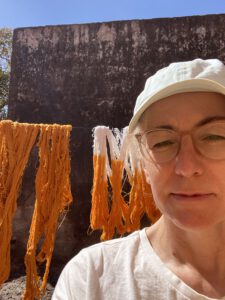
Me and skeins of dyed yarn
Education is the keyword I go in with. I want to know if I can also learn how to weave. As an answer, Franceline introduces me directly to my future boss, Tensoba. I watch her at her loom for a while. She doesn’t sit there for very long, because either one of the fine cotton warp threads breaks or the weft thread on a small plastic tube – called Pandé in Dioula – which dances loosely in a small wooden boat, must be renewed. Then I am allowed to sit down at the metal loom for the first time, even the bar stool with too short legs on which I sit is made of metal and very uncomfortable to sit on. While I’m still trying to understand what I’m supposed to do with my hands, Tensoba admonishes me that I should now press down on the pedals with all my might, alternately. Even with all my strength I don’t manage it at first. I feel like putting both feet on the pedal. After several attempts and all the strength, I can muster with one leg, the pedal finally lowers and the warp threads open. I push the shuttle through the thread tunnel and pull the comb twice hard against the already woven fabric. This way the woven fabric grows millimeter by millimeter. Tensoba says, “Well, you’ll learn step by step.” We agree on when I will start the training. In the meantime, Franceline has already driven my aunt back home on her moped. Slightly discouraged, I return my way back home on the red sandy track at 35 degrees.
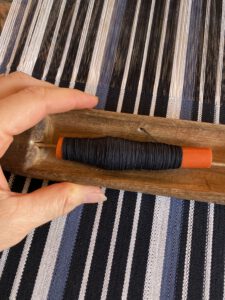
Weaving the “president”-motif
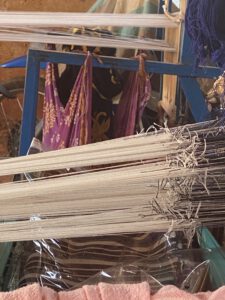
Tidy chaos
I learn that weaving is real back-breaking work in the first week at the “Vie meilleure” association. Before we can even start weaving, two of us carry the heavy looms out of the storage room in the morning to a location where there is either little wind or little sun on the open plot. Then the long warp threads are stretched, that is, fixed at up to 21 meters from the loom with an iron hook and heavy stones. When this is done, a true Sisyphos job begins. Around 100 threads are to be untangled. I learn that you need a lot of patience for this work. For me as a “Toubabouh Mousso” – white woman – sun protection is also an advantage. Sometimes we stand for several hours in the blazing sun with our backs bent over the cotton strands. The increasingly strong Harmatan, a desert wind from Niger, makes weaving even more difficult. It not only drives through the freshly sorted rows of thread, but also raises a lot of red dust that soils the threads.
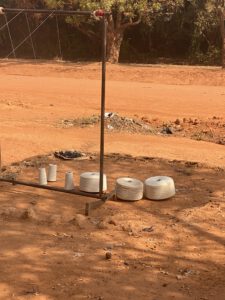
Spools of yarn in the dust

Harmatan moving the threads
Sore muscles and happiness
When, despite all the adversities, which my colleagues endure stoically and chatting, order is restored to the chaos of threads and the rows of the warp open effortlessly, the big moment arrives around noon: the weaving can begin! While Tensoba sorted the long-stretched threads today, I produced Pandé. For this, a dyed strand of cotton is placed on a rudimentarily soldered-together metal cross and wound onto plastic tubes with a handwheel. Until a skein is unwound, I sit in a rather bent position for about 45 minutes. But then I finally get to the loom. I’m already dreaming of meditative rhythm and harmonious coordination of hand and foot movements. But I am still far from that. After two hours at the loom with maximum use of the strength in my feet, I ask myself how the other women can weave for a whole day.
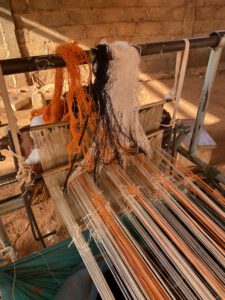
A day’s work to change the warp threads
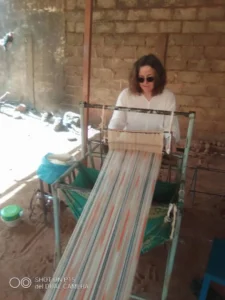
My first try
During the lunch break, everyone puts the pots they brought with them on the sandy ground, and there is water to drink from the tap. We all eat To (maize porridge) with sauces made from leaves, flowers, or okra. The break feels so good after the effort. Some women pray in the small storeroom before eating or lie down on one of the wooden benches after the meal, where the finished cloth panels are also measured out. I am already longing for the end of the day. Tensoba notices that I can’t take any more and sits down at the machine for another round. I watch with interest as she reknots and rearranges the torn threads, and as the fabric, the pagne, grows and grows. On the way home, exhausted, I enjoy the warming rays of the sun. Children coming from school greet me and I am very grateful and happy!
In the next post you will learn why my training in weaving ends and how the first collection “Made in Burkina” comes into being.
……………..
Weben für ein besseres Leben
Auf der nächsten Etappe meiner Reise durch Burkina Faso lerne ich unter anderem, wie Faso dan Fani gewebt wird – eine wichtige Erfahrung, um eigene Motive zu entwickeln, die ich später in Auftrag geben möchte. So viel vorab, die Arbeit am mechanischen Webstuhl ist körperlich und geistig anstrengend und erfordert eine Menge Zeit und Geduld. Umso schöner und wertvoller ist deshalb das Ergebnis: Hochwertige und wunderschöne Baumwollstoffe, meist von Frauen gewebt. Das traditionelle Handwerk sichert ihnen ein Einkommen und ein Stück Unabhängigkeit.
Ende November geht meine Reise weiter von Ouagadougou nach Bobo Dioulasso. Die Stadt ist hauptsächlich von Menschen der ethnischen Gruppe der Dioulas bevölkert – so heißt auch die Sprache, die ich überall höre. Der Islam und die fünf Gebete bestimmen das tägliche Leben der Menschen. Ab 4:00 Uhr morgens ist es in meinem Stadtviertel vorbei mit der Nachtruhe, denn die Imame der umliegenden Moscheen rufen sozusagen im Kanon zum Gebet. Bobo gilt als die Wirtschafts- und Kulturhauptstadt von Burkina Faso. Von hier aus wird mit allem gehandelt, was vorstellbar ist. Da die zweitgrößte Stadt von Burkina Faso mit milderen Temperaturen und größeren Regenmengen ein wahrer Gemüsegarten ist, werden Kohl, grüne Bohnen, Zwiebeln, Tomaten, Karotten und Salat tonnenweise nach Mali und in die Elfenbeinküste exportiert. Auch das besonders hochwertige Maismehl für das Nationalgericht „To“ ist sehr gefragt in den Nachbarländern. Meine Tante hat unlängst einen Zentner Maismehl per Taxi nach Bamako geschickt, um eine Hochzeitsgesellschaft glücklich zu machen: und es hat funktioniert!
Hadja Awa öffnet Türen

Franceline
Die zweitgrößte Stadt des Sahel-Staates empfängt mich sehr herzlich und nachdem ich meiner Tante Hadja Awa erklärt habe, dass ich lernen möchte, Faso dan Fani zu weben und sehen möchte, wie der Alltag in einem Atelier aussieht, geht alles sehr schnell. Obwohl Sonntag ist, sitzt keine Stunde später Lassina Paré neben mir auf der Terrasse meiner Tante: Er hat seit mehr als zehn Jahren ein eigenes Atelier und lädt mich herzlich zu sich ein. Er begutachtet gleich die Ausführung des Ärmelschlitzes an meinem Hemd und ist nicht zufrieden: Der Mann kennt sich aus, denke ich. Als Lassina sich verabschiedet, fällt meiner wunderbaren Tante, Hadja Awa, ein, dass unweit von ihrem Haus Frauen weben.
Wir verabreden uns für den kommenden Tag, um dem Verein einen Besuch abzustatten. Mit dem Spaziergang zu den Weberinnen haben wir uns dann gleich ein wenig übernommen, es ist einfach heiß und die Straße unglaublich staubig. Franceline, die Präsidentin des Vereins empfängt uns zunächst etwas zurückhaltend. Meine Tante und ich erklären ihr, was ich vorhabe und sie beginnt ein wenig zu erzählen. Sie hat einen Verein für die Ausbildung von jungen taubstummen Frauen gegründet. „Mich hat vor ein paar Jahren ein taubstummer Junge auf der Straße angebettelt. Ich habe ihm gesagt, dass er doch auch trotz seines Handcaps arbeiten können, ein Handwerk lernen, zum Beispiel das Weben“, erklärt die engagierte Frau. „Schließlich habe ich einen Verein gegründet, der von der burkinischen Regierung gefördert wird. Wir bilden hier beeinträchtigte und gesunde Mädchen aus. Ein paar Frauen, die hier ihre Ausbildung gemacht haben, sind geblieben und helfen bei der Produktion des traditionell gewebten Baumwollstoffs Faso da Fani.“
Im Fadenland

Schwitzen unter Garnsträngen
Ausbildung ist das Stichwort, mit dem ich einsteige. Ich möchte wissen, ob ich auch das Weben lernen darf. Auf meine Frage hin, stellt mich Franceline direkt meiner künftigen Chefin Tensoba vor. Ich beobachte sie eine zeitlang an ihrem Webstuhl. Dort sitzt sie nicht sehr lange, denn entweder reisst einer der feinen Baumwollkettfäden oder der Schussfaden auf einem Kunsstoffröhrchen – auf Dioula Pandé genannt – das locker in einem kleinen Holzschiffchen tanzt, muss erneuert werden. Dann darf ich mich das erste Mal an den Webstuhl aus Metall setzen, auch der Barhocker mit zu kurz geratenen Beinen, auf dem ich Platz nehme, ist aus Metall und entsprechend hart. Während ich noch versuche, zu verstehen, was ich mit den Händen machen soll, ermahnt mich Tensoba, dass ich nun die Pedale mit aller Kraft heruntertreten soll, und zwar abwechselnd. Auch mit aller Kraft schaffe ich es zunächst nicht. Ich habe Lust, mit beiden Füßen auf das Pedal zu steigen. Nach mehreren Versuchen und aller Kraft, die ich mit einem Bein aufbringen kann, senkt sich endlich das Pedal und die Kettfäden öffnen sich, ich schiebe das Schiffchen durch den Fadentunnel und ziehe den Kamm zweimal kräftig gegen den schon gewebten Stoff. So wächst die Wirkware Millimeter um Millimeter. Tensoba meint: „Naja, Du wirst das Schritt für Schritt lernen.“ Wir vereinbaren, wann ich mit der Ausbildung starte. Franceline hat meine Tante in der Zwischenzeit bereits mit dem Moped nach Hause gefahren. Leicht entmutigt trete ich bei 35 Grad den Rückweg auf der roten Sandpiste an.

Das Modell “Président”

Aufgeräumtes Chaos
Dass Weben echte Knochenarbeit ist, lerne ich in der ersten Woche beim Verein „Vie meilleure“. Bevor wir überhaupt mit dem Weben anfangen können, tragen wir die schweren Webstühle morgens zu zweit aus dem Lagerraum an einen Standort, auf dem offenen Grundstück entweder wenig Wind oder wenig Sonne zu erwarten ist. Dann werden die langen Kettfäden gespannt, das heißt, in bis zu 21 Metern Entfernung vom Webstuhl mit einem Eisenhaken und schweren Steinen fixiert. Wenn das getan ist, beginnt eine wahre Sisyphos-Arbeit. Die etwa 100 Fäden werden entwirrt. Ich lerne, dass man für diese Arbeit viel Geduld braucht. Für mich als „Toubabouh Mousso“ – weiße Frau – ist auch Sonnenschutz von Vorteil. Manchmal stehen wir mehrere Stunden in der prallen Sonne mit gebeugtem Rücken über den Baumwollsträngen. Der immer stärker wehende Harmatan, ein Wüstenwind aus dem Niger, erschwert das Weben zusätzlich. Er fährt nicht nur durch die frisch sortierten Fadenreihen, sondern wirbelt zudem eine Menge roten Staub auf, der die Fäden verschmutzt.

Garnspulen im Staub

Der Harmatan bewegt die meterlangen Kettfäden
Muskelkater und Glück
Wenn dann trotz aller Widrigkeiten, die meine Kolleginnen plaudernd und stoisch ertragen, wieder Ordnung im Fadenchaos herrscht, und sich die Reihen der Kette mühelos öffnen, kommt gegen Mittag der große Moment: Das Weben kann beginnen! Während Tensoba heute die lang gespannten Fäden sortiert hat, habe ich Pandé produziert. Dazu wird ein gefärbter Strang Baumwolle auf ein rudimentär zusammengelötetes Metallkreuz gelegt und mit einem Handrad auf Plastikröhrchen gespult. Bis ein Strang abgewickelt ist, sitze ich etwa 45 Minuten in ziemlich gebeugter Haltung. Doch dann geht es endlich an den Webstuhl. Ich träume schon vom meditativen Rhythmus und harmonischer Koordination von Hand- und Fußbewegungen. Doch davon bin ich noch weit entfernt. Nach zwei Stunden am Webstuhl mit maximalem Krafteinsatz meiner Fußballen, frage ich mich, wie die anderen Frauen einen ganzen Tag weben können.

Das Anknoten der neuen Fäden dauert einen Tag

My first try
In der Mittagspause stellen alle ihre mitgebrachten Töpfchen auf den sandigen Boden, zu trinken gibt es Wasser aus dem Hahn. Wir essen alle To (Maisbrei) mit Saucen aus Blättern, Blüten oder Okraschoten. Die Pause tut nach der Anstrengung so gut. Einige Frauen beten vor dem Essen im kleinen Lagerraum oder legen sich nach der Mahlzeit auf eine der Holzbänke, auf denen auch die fertigen Stoffbahnen ausgemessen werden. Ich sehne jetzt schon den Feierabend herbei. Tensoba merkt, dass ich nicht mehr kann und setzt sich selbst noch eine Runde an die Maschine. Interessiert verfolge ich, wie sie die gerissenen Fäden neu verknotet und arrangiert, und wie die Stoffbahn, der Pagne, wächst und wächst. Auf dem Heimweg genieße ich erschöpft die wärmenden Sonnenstrahlen. Kinder, die von der Schule kommen, grüßen mich und ich bin sehr dankbar und glücklich!
Im nächsten Beitrag erfahrt Ihr, warum meine Ausbildung im Weben ein abruptes Ende nimmt und wie die erste Kollektion „Made in Burkina“ entsteht.
…………
Tisser pour une vie meilleure
Lors de la prochaine étape de mon voyage au Burkina Faso, j’apprendrai notamment comment est tissé le Faso dan Fani – une expérience importante pour développer mes propres modèles que je souhaite ensuite commander. Autant dire d’emblée que le travail sur un métier à tisser mécanique est physiquement et mentalement éprouvant et demande beaucoup de temps et de patience. Le résultat en est donc d’autant plus beau et précieux : de magnifiques tissus en coton de grande qualité, tissés pour la plupart par des femmes. Cet artisanat traditionnel leur assure un revenu et une certaine indépendance.
Fin novembre, mon voyage se poursuit de Ouagadougou à Bobo Dioulasso. La ville est principalement peuplée de personnes de l’ethnie dioulas – c’est aussi le nom de la langue que j’entends partout. L’islam et les cinq prières régissent la vie quotidienne des habitants. Dès 4 heures du matin, c’en est fini du repos nocturne dans mon quartier, car les imams des mosquées environnantes appellent à la prière en canon, pour ainsi dire. Bobo est considérée comme la capitale économique et culturelle du Burkina Faso. D’ici, on fait le commerce de tout ce qui est imaginable. Comme la deuxième ville du Burkina Faso, avec ses températures plus douces et ses pluies plus abondantes, est un véritable jardin potager, choux, haricots verts, oignons, tomates, carottes et salades sont exportés par tonnes vers le Mali et la Côte d’Ivoire. La farine de maïs de qualité supérieure pour le plat national “To” est également très demandée dans les pays voisins. Ma tante a récemment envoyé un quintal de farine de maïs en taxi à Bamako pour faire plaisir à la mariage d’un jeune couple: et ça a marché!
Hadja Awa ouvres des portes

Franceline
La deuxième ville de l’État sahélien m’accueille très chaleureusement et après avoir expliqué à ma tante Hadja Awa que je souhaite apprendre à tisser le Faso dan Fani et voir à quoi ressemble le quotidien d’un atelier, tout va très vite. Bien que ce soit dimanche, moins d’une heure plus tard, Lassina Paré est assis à côté de moi sur la terrasse de ma tante: il a son propre atelier depuis plus de dix ans et m’invite chaleureusement chez lui. Il examine immédiatement la réalisation de la fente de la manche de ma chemise et n’est pas satisfait: Cet homme s’y connaît, je pense. Alors que Lassina prend congé, ma merveilleuse tante, Hadja Awa, se souvient que des femmes tissent non loin de sa maison.
Nous nous donnons rendez-vous pour le lendemain afin de rendre visite à l’association. En nous promenant chez les tisserandes, nous avons tout de suite pris un peu de retard, il fait tout simplement chaud et la route est incroyablement poussiéreuse. Franceline, la présidente de l’association, nous accueille d’abord avec une certaine réserve. Ma tante et moi lui expliquons ce que je veux faire et elle commence à nous raconter un peu. Elle a fondé une association pour la formation de jeunes femmes sourdes-muettes. “Il y a quelques années, un jeune sourd-muet m’a suppliée dans la rue. Je lui ai dit qu’il pouvait tout de même travailler malgré son handicap, apprendre un métier, par exemple le tissage”, explique cette femme engagée. “Finalement, j’ai créé une association qui est soutenue par le gouvernement burkinabé. Nous y formons des filles handicapées et des filles en bonne santé. Quelques femmes qui ont fait leur formation ici sont restées et aident à la production du tissu de coton Faso da Fani, tissé de manière traditionnelle”.
Au pays du fil

Chaleur et fils sautés
La formation est le mot-clé par lequel j’entre en scène. Je voudrais savoir si je peux aussi apprendre à tisser. En réponse à ma question, Franceline me présente directement à ma future patronne, Tensoba. Je l’observe un moment sur son métier à tisser. Elle n’y reste pas très longtemps, car soit l’un des fins fils de chaîne en coton se casse, soit le fil de trame sur un petit tube en plastique – appelé pandé en dioula – qui danse librement dans une petite navette en bois doit être renouvelé. Ensuite, je peux m’asseoir pour la première fois sur le métier à tisser en métal, le tabouret de bar aux pieds trop courts sur lequel je m’assois est également en métal et donc dur. Alors que j’essaie encore de comprendre ce que je dois faire avec mes mains, Tensoba me rappelle que je dois maintenant appuyer de toutes mes forces sur les pédales, et ce à tour de rôle. Même avec toute ma force, je n’y arrive pas au début. J’ai envie de monter sur la pédale avec les deux pieds. Après plusieurs tentatives et toute la force que je peux déployer avec une seule jambe, la pédale s’abaisse enfin et les fils de chaîne s’ouvrent, je pousse la navette à travers le tunnel de fils et tire deux fois vigoureusement le peigne contre le tissu déjà tissé. Ainsi, le tricot pousse millimètre par millimètre. Tensoba me dit: “Eh bien, tu vas l’apprendre petit à petit”. Nous convenons de la date à laquelle je commencerai l’apprentissage. Entre-temps, Franceline a déjà ramené ma tante chez elle en mobylette. Légèrement découragée, je prends le chemin du retour par 35 degrés sur la piste de sable rouge.

Tissage du modèle prèsident

Chaos ordonné
J’apprends dès ma première semaine à l’association “Vie meilleure” que le tissage est un véritable travail de forçat. Avant même de pouvoir commencer à tisser, nous transportons le matin à deux les lourds métiers à tisser depuis le local de stockage jusqu’à un emplacement sur le terrain ouvert où il y a soit peu de vent, soit peu de soleil. Ensuite, les longs fils de chaîne sont tendus, c’est-à-dire fixés à une distance pouvant atteindre 21 mètres du métier à tisser à l’aide d’un crochet en fer et de lourdes pierres. Une fois cela fait, un véritable travail de Sisyphe commence. Les quelque 100 fils sont démêlés. J’apprends qu’il faut beaucoup de patience pour ce travail. Pour moi, en tant que “Toubabouh Mousso” – femme blanche – la protection contre le soleil est également un avantage. Parfois, nous restons plusieurs heures en plein soleil, le dos courbé au-dessus des écheveaux de coton. L’harmatan, un vent du désert venu du Niger, qui souffle de plus en plus fort, rend le tissage encore plus difficile. Non seulement il traverse les rangées de fils fraîchement triés, mais il soulève en outre une grande quantité de poussière rouge qui salit les fils.

Bobines dans la poussière

Le harmatan bouge les fils de plusieurs metres des longueur
Courbatures et bonheur
Lorsque, malgré toutes les adversités que mes collègues supportent en bavardant et stoïquement, l’ordre règne à nouveau dans le chaos des fils et que les rangées de la chaîne s’ouvrent sans effort, le grand moment arrive vers midi: le tissage peut commencer! Aujourd’hui, pendant que Tensoba triait les fils longuement tendus, j’ai produit du pandé. Pour ce faire, un brin de coton teint est placé sur une croix métallique rudimentaire soudée et enroulé sur des petits tubes en plastique à l’aide d’un volant. Jusqu’à ce qu’un écheveau soit déroulé, je reste assis pendant environ 45 minutes dans une position assez courbée. Mais ensuite, je me mets enfin au métier à tisser. Je rêve déjà d’un rythme méditatif et d’une coordination harmonieuse des mouvements des mains et des pieds. Mais j’en suis encore loin. Après deux heures passées sur le métier à tisser en utilisant au maximum la force de la plante de mes pieds, je me demande comment les autres femmes peuvent tisser toute une journée.

Changer les fils dure toute une journée

My first try
A la pause de midi, tout le monde pose les petits pots qu’il a apportés sur le sol sablonneux, et il y a de l’eau à boire au robinet. Nous mangeons tous du to (bouillie de maïs) avec des sauces à base de feuilles, de fleurs ou de gombos. La pause fait tellement de bien après l’effort. Certaines femmes prient avant le repas dans le petit entrepôt ou s’allongent après le repas sur l’un des bancs en bois où l’on mesure également les panneaux de tissu terminés. J’attends déjà avec impatience la fin de la journée. Tensoba remarque que je n’en peux plus et s’assoit encore une fois devant la machine. Je suis avec intérêt la manière dont elle renoue et réorganise les fils cassés, et dont le pan de tissu, le pagne, grandit et grandit encore. Sur le chemin du retour, épuisée et légèrement découragée, je profite des chauds rayons du soleil. Des enfants qui reviennent de l’école me saluent et je suis très reconnaissante et heureuse !
Dans le prochain article, vous découvrirez pourquoi ma formation en tissage s’arrête brusquement et comment la première collection “Made in Burkina” voit le jour.
